Incredible Scottish Loch Monsters
How many Scottish loch monsters can you name?
Just about everyone has heard of Nessie, but did you know that there are many other Scottish lochs that have strange creatures, or monsters, of their own?
There are approximately 30,000 lochs in Scotland, the majority are freshwater lochs, but there are several sea lochs, most of them on the western coast of the Highlands.
Many of these lochs are interconnected by a network of rivers, or by access to the open ocean, or both. Theories exist that one, or several, creatures could move from loch to loch, or from loch to open ocean and back again. It's also been suggested that there are underwater caverns and tunnels that may connect some of the closest lochs. As far as I know, no one has actually proven these exist. But the water in Scotland's lochs is so cold, dark, and deep, that it has defied many expeditions and jealously guards it's secrets.
Of course Loch Ness’ Nessie is by far the most famous of Scotland's monsters, with Morag (from Loch Morar) coming in a distant second, but the others may come as a complete surprise to you.
Scotland and it’s culture is wreathed in mystery, magic and the supernatural.
In fact, the world of the wee folk (fairies, brownies and their relatives), mystical creatures, witchcraft, and a belief in the supernatural is woven throughout Scottish history, with accounts and sightings of loch monsters appearing regularly over the centuries.
But when it comes to the creatures in Scotland's lochs, the point at which folklore and imagination separates from physical reality is blurry.
 Sea Lizard (Plesiosaurus) from 'Extinct Monsters' 1896. Public Domain.
Sea Lizard (Plesiosaurus) from 'Extinct Monsters' 1896. Public Domain.Historically, the earliest accounts of fantastic creatures in Scotland's lochs endowed them with mystical or magical powers, including shape-shifting, but over time the monsters have taken on a more tangible, flesh-and-blood persona.
Although loch creatures are generally seen IN the water, there have been many documented sightings of them on land, and even in the waterways surrounding, and connecting, the lochs.
This could indicate that if the creatures do exist, they can travel between lochs, even entering rivers or swimming out into the surrounding seas. Fascinating stuff!
"While much is too strange to be believed, nothing is too strange to have happened.” ― Thomas Hardy.
To make sure I've included as much detail as possible, without turning this page into a novel, I've also created separate pages for the lochs with the most sightings, or the most detailed sighting/s.
You'll find the links to those at the end of that particular loch monster's story summary.
List of Scottish Loch Monsters
I can't claim that this is a list of ALL the monsters or creatures that have been reported to live in the deep, cold, dark waters of Scotland's lochs.
There are way too many lochs, and far too many stories, for me to fit on one, or even several, webpages. For that I'd need to write a book, and that's something I don't intend doing :)
Regardless, I hope you enjoy the results of my research. It was fascinating and enormously time-consuming to do, but I learned so much and am now convinced that there was (and maybe still is) something strange, or maybe several somethings, rearing it's head in Scottish waters.
Read on and make up your own mind!
Loch Ness - Nessie
Loch Ness holds more water than any other Scottish loch, and at one time was thought to be 'bottomless'. It's a long, slender body of water with a maximum depth of 745 feet and an average width of just over one mile.
Loch Ness was formed along the sixty two mile long Great Glen Fault Line, and with a steep drop off on both sides the majority of the loch is deep water.
‘Many a man has been hanged on less evidence than there is for the Loch Ness Monster’ – G.K.Chesterhorn, English writer and philosopher
Surrounded by rugged, and hauntingly beautiful, scenery the deep, dark waters of Loch Ness are said to be home to Nessie, the famous Loch Ness monster.
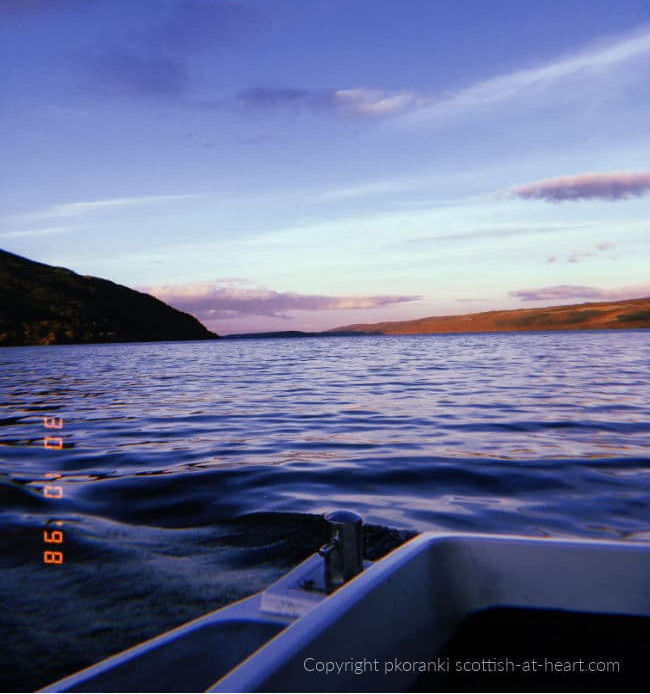 Loch Ness at sunset taken on the water
Loch Ness at sunset taken on the waterThe earliest documented sighting of a strange creature in Loch Ness was in 565 AD, by an Irish monk and priest who would later become St. Columbus. While traveling in Scotland he stopped the monster from killing one of his monks by invoking the name of the Lord. This encounter was recorded in writing by St. Adamnan over one hundred years later when he was compiling a list of St. Columba's miracles.
There were a handful of sightings of the monster between St. Columba's encounter with it, and the 1930's when Nessie sightings took off with a vengeance. Scottish folklore descriptions of water beasts often included horse-like features which fit with mythical creatures such as the Kelpie, more recent sightings describe a more prehistoric type creature although a 'horse-like head' or a 'horse's mane' are still sometimes seen.
Documented eyewitness accounts from the 1800's and early 1900's generally describe a dark gray or black creature, with a long neck, small head, and humps showing above the water line (these were often described as looking like upturned boats). However, other characteristics occasionally appear including the occasional equine feature.
After the completion of the A82 road in 1933, which runs the full length of the northwestern shore of Loch Ness, Nessie sightings took off! This road hugs the shore, at times only a stone's throw from the water, and makes it one of the most accessible, and easily visible, lochs in Scotland.
Since this time there have been thousands of sightings of a strange creature on the loch, generally by people who weren't even looking for her.
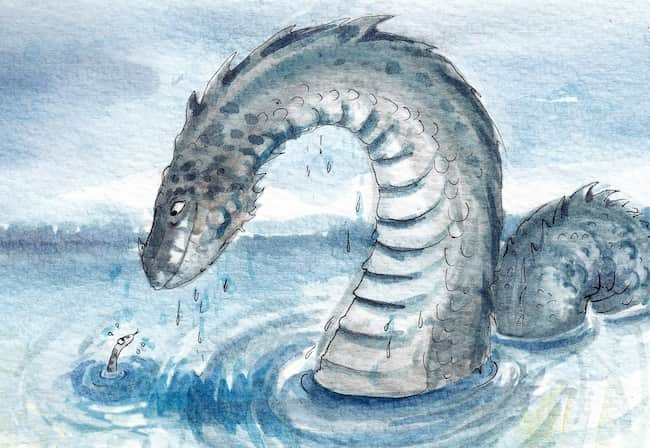
Although most of the time the Loch Ness monster is seen in the water, there have been several sightings of her on the shore.
The descriptions given by eyewitnesses are still almost identical to those given in earlier; a dark colored, long-necked creature with a small head and often with humps showing above the water. It would seem that Nessie can lie motionless on the surface of the water, move through it slowly, or get up some significant speed.
The details given by eye witnesses since the early to mid 1900's resemble a prehistoric plesiosaur type creature.
There are so many documented eyewitness accounts, as well as videos and photographs, I created a page just for Nessie. You can find tons more fascinating details plus links to articles, and video 'evidence' on that page, just CLICK HERE to check it out.
Loch Morar - Morag
If Scotland's loch monsters prefer deep, dark water with a healthy dose of tranquility, then Loch Morar could be a great place to spot one. In fact, in terms of the number of sightings, this loch is in the #2 position, which is impressive given how relatively isolated it is compared to Loch Ness.
But, even though Morag could be considered Scotland's 'other loch monster', the difference in the number of sightings is HUGE, with Morag having 34 recorded sightings v Nessie's thousands!
At almost twelve miles long and with a maximum depth of over 1000 feet, this remote loch is the deepest body of freshwater in Britain. It's surrounding landscape is stunning, and out on the loch there are five separate, wooded islands.
It's located on the beautiful and rugged west coast of the Scottish Highlands, separated from the open ocean by strip of land about one mile wide. The south side of the loch is only accessible by boat or on foot.
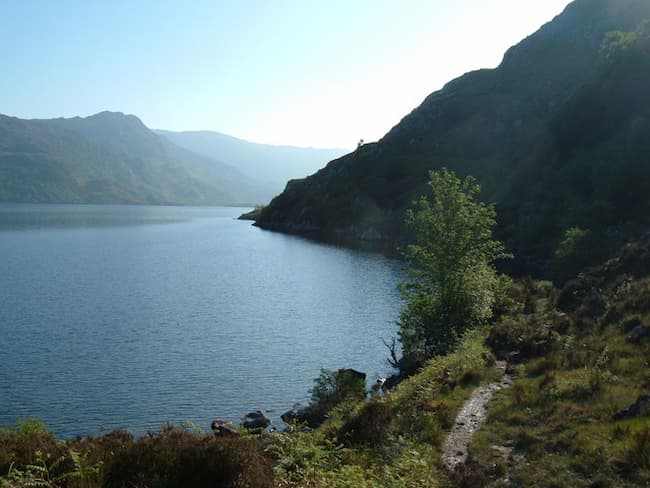 View from the eastern end of Loch Morar
View from the eastern end of Loch Morar
By John Haynes, CC BY-SA 2.0, https://commons.wikimedia.org/w/index.php?curid=9313495
The earliest documented sighting of a monster in the loch was in 1887, and it's thanks to a Scot called Alexander Carmichael that we're able to learn about some of the earliest sightings and how the Loch Morar monster was thought of by locals over a century ago.
In the late 1800's Carmichael spent half a century collecting information, folklore and stories of Celtic origin, originally recording them in his notebooks in Gaelic. In the early 21st century, researcher from Edinburgh University's Carmichael-Watson Project named Dr Donald Steward found some previously unseen documents where Carmichael had made notes about the folklore surrounding Loch Morar's creature.
In his notes from that time, Carmichael says that according to local legends, Morag was usually seen before a death or a drowning, of one of the family members whose ancestral homes were in that area, having been seen at the death of Aeneas Macdonnell in 1898.
The descriptions given to Carmichael at this time are generally in line with Celtic myths and legends surrounding strange water creatures rather than as a prehistoric type animal as in sightings from the 1900's.
She was often said to resemble a mermaid, being 'half-human and half-fish', although his notes show Morag to have also been described as 'a black heap or ball slowing and deliberately rising in the water and moving along like a boat waterlogged'. This sounds much more like the creature eyewitnesses have seen in more recent time.
Almost every documented report of Loch Morar's creature being seen in the 20th century and beyond has several eyewitnesses seeing the same thing simultaneously. In many of the accounts, eyewitnesses also seems to be seeing a creature with similar features, including dark colored skin, a long neck, small head and humps.
In 1969, Robert Duff from Edinburgh got the closest look at, and gave the most detailed description of, the Loch Morar creature. He was so close and it was so unexpected that he left the area quickly in a panic, and by the time he went back to try to take a photograph the creature was gone.
The most recent, recorded sighting of Morag that I could find was in 2019, when the Loch superintendent saw two large, unknown shapes crossing the loch.
As with Loch Ness, there are too many details and too much info. on Loch Morar's monster sightings to put them on this page, but you can read all about them HERE!
Loch Hourn
Loch Hourn is a fjord-like sea loch situated on the wild and rocky western coast of Scotland. At the western end it opens into the Sound of Sleat, a stretch of ocean that separates that area of mainland Scotland from the Isle of Skye.
It measures approximately fourteen miles in length and has a maximum depth of 600 feet.
As Loch Hourn is open to the ocean it has both strong, erratic currents and wild winds, these can make boating hazardous and even dangerous, with deaths having been reported in the past.
It's a remote loch, with no major roads running close by, and much of the shoreline is accessibly only on foot or by boat. The highland scenery is spectacular and rugged, and there's an abundance of wildlife in and around Loch Hourn.
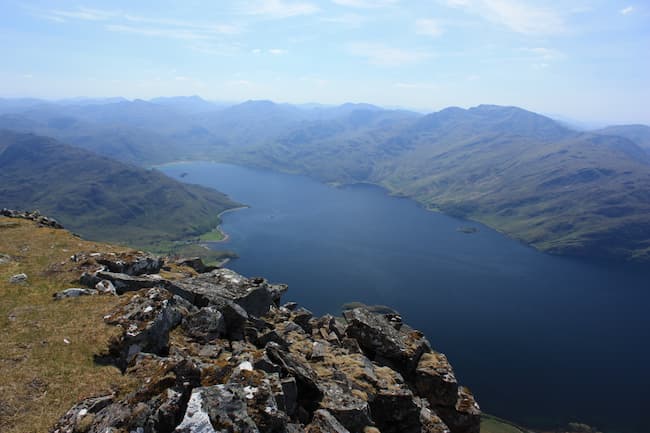 Loch Hourn, looking south-east from Beinn Sgritheall
Loch Hourn, looking south-east from Beinn Sgritheall
By Nick Bramhall from Aberdeen, UK - Loch Hourn, CC BY-SA 2.0, https://commons.wikimedia.org/w/index.php?curid=8316155
There are few documented sightings of a strange creature on Loch Hourn, but in spite of it's isolation, it has the distinction of being the location of one of the most incredible loch monster sightings I came across in my research.
In 1872, six people aboard a small yacht called the 'Leda' saw the loch creature repeatedly over a period of two days.
In the same timeframe it was seen by numerous, otherwise unconnected people on and around both the loch, the ocean and the Isle of Skye.
Luckily, the witnesses to this fantastic spectacle made written reports of what they had seen right almost immediately afterward, and these contain so much detail as to be spine-tingling!
The creature that was seen multiple times again resembles the Loch Ness and Loch Morar 'monsters' being dark in color and having a long neck, small head and multiple 'humps'.
Again, there are way too many words, and too much detail, to include the Loch Hourn monster sightings, but you can CLICK HERE to read all the details. It's well worth the read!
Loch Oich - Wee Oichie or Oichy
Loch Oich is a relatively small, narrow, freshwater loch which sits between Loch Ness and Loch Lomond in the Scottish Highlands.
It's approximately four miles long and has a maximum depth of 154 feet, and is connected by water to both Loch Ness and Loch Lomond.
There have been eyewitnesses who claimed to see a large, unidentified creature traveling between Loch Oich and Loch Ness.
The descriptions of Loch Oich’s monster is a little different from many of the other loch monsters in appearance, but still has the familiar long neck, black skin and coils, or humps. However, one eyewitness described the head as being 'dog like' and that the creature had the flowing mane of a horse.
There are sightings of this monster in the late 1800’s but are undocumented and I wasn’t able to find any details.
There is an unsubstantiated story from the early 1900’s which describes a tragic incident when a child/youth climbed onto the monsters back while it was lying on the shore (perhaps while it was sleeping).
This roused the monster who dived out and down into the loch, taking the child with it. He was never seen again. Even if this is true, it doesn’t sound as though the monster was deliberately trying to harm the child, nonetheless it did result in it being labeled a ‘child killing monster’.
This account has echoes of the legendary and mythical Each-Uisge monster, a dangerous and vicious type of supernatural water horse said to live in loch water and having shape-shifting abilities.
The Each-Uisge is often described as having smooth yet sticky, green-black skin and employing the same tactics as the Kelpie… taking anyone hapless enough to climb on it’s back down into the depths of the loch to drown, and then eaten!
The Each-Uisge is said to be a shape-shifting creature, putting it in the realm of magic rather than ancient worldly creatures like dinosaurs.
1936: A confirmed and documented sighting of Wee Oichie took place when a man in a boat out on the loch saw a big, black creature rise up out of the water at the northern end of the loch. A J Richards described the monster as having two humps, a vaguely dog-like head and the coils of a snake. A giant otter perhaps?
1998: two locals who were driving alongside the loch saw a big, dark hump rise out of the water about 20 yards from the shore. They estimated the width of the coil which created the hump to be around eighteen inches in diameter, so it’s possible it was a giant eel, or the slimmer, tail end of a much bigger creature.
Loch Quoich
Loch Quoich (means ‘loch of the quaich’, a quaich being a traditional Scottish shallow, two handled cup or bowl) is both a loch and a reservoir and sits about 40 miles directly west of Loch Oich.
It’s isolated, lonely and beautiful, surrounded by the Highlands craggy hills and the rugged mountain peaks of the ‘Four Munros of Gleouraich, Spidean Mialach, Sgurr a’Mhaoraich and Gairich.
Munros are Scottish mountains that are over 3000 feet tall, there are approximately two hundred and seventy-seven of these in Scotland.
Loch Quoich is approximately nine miles long with a maximum depth of 281 ft.
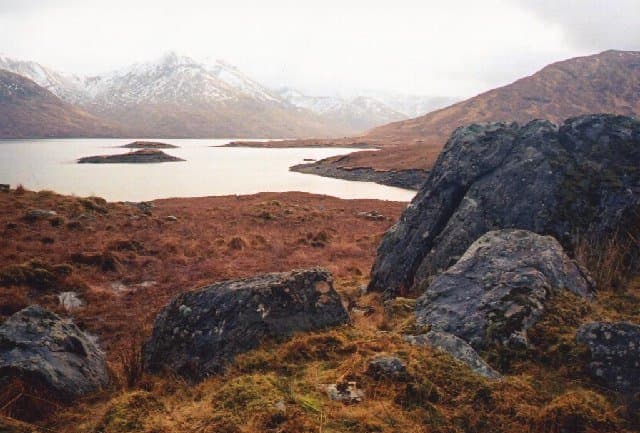 Loch Quoich, looking southwest
Loch Quoich, looking southwest
By Pip Rolls, CC BY-SA 2.0, https://commons.wikimedia.org/w/index.php?curid=638588
There have been very few sightings of a monster in Loch
Quoich, with early mentions by locals of a beast in the loch being in the late
1800’s being simply oral recounts not recorded.
The only documented one I could find being during the 1930’s when a local Lord (no name given) was fishing from the shore with two fishing guides and saw a large, serpentine creature with a horse-like head lying on the stones of a nearby beach.
There were a couple of unconfirmed sightings reported by a local newspaper in 1933, but other than that the monster of Loch Quoich has existed relatively undetected and unseen.
The unusual horse-like features are similar to some given in the description an early 1900's sighting of Wee Oichie, the monster of Loch Oich who was reported as having been seen on the shore in the early 1900’s and then making off with a child on it's back on it.
Loch Shiel - Sheilagh or Seileag
Loch Shiel is again, in the same general area of the Scottish Highlands, being about ten miles south of Loch Morar, fifteen miles west of Loch Linnhe, about twelve miles west of Fort William. It's part of the Loch Shiel National Scenic Area.
It’s a fairly remote, freshwater loch approximately seventeen and a half miles long, and with maximum depth of 393 feet.
Loch Shiel has two claims to fame at completely opposite ends of the historical spectrum.
- In 1815 the Glenfinnan Monument was erected at the head of Loch Shiel to commemorate it as the spot where in 1745, Bonnie Prince Charlie raised his family standard at the beginning of the Jacobite Uprising.
- Loch Shiel is also the inspiration for the ‘Black Lake’ featured in the fictional world of Harry Potter.
There are many neolithic remains in this area, as well as reminders of the Norse (Viking) invaders and occupation.
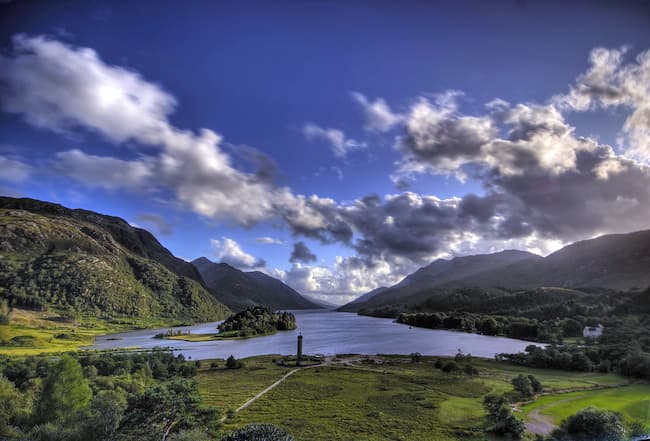 Loch Sheil and the Glenfinnan Monument
Loch Sheil and the Glenfinnan MonumentBy Gil Cavalcanti - Own work, CC BY-SA 3.0, https://commons.wikimedia.org/w/index.php?curid=7484570
According to Hebridean folklore, a Seileag (Siolag
is an ancient word meaning slender fish/eel) was an enormous eel that lived in
the ocean, but sometimes entered lochs.
In Scenes in Lewis, The Celtic Review, Volume V by Donald MacKinnon in 1908, the author describes the Seileag which was reported to live in Loch Liurboist on the Isle of Lewis in the Outer Hebrides. According to this article, a seileig was an eel like creature that used to come into the lochs from the ocean.
However, Loch Shiel’s monster has been described by eye witnesses as having between three and seven humps on it’s back and a long neck, more like the plesiosaur type creature.
Although local tales have it that there were sightings of the Loch Shiel monster as early as 1870, there are only a few documented sightings that I could find.
A Benedictine priest named Father Cyril Dieckhoff who was based at Fort Augustus Abbey (located at the southern tip of Loch Ness) was extremely interested in, and dedicated to, collecting reports and eyewitness accounts of sightings of the Loch Shiel monster.
Although he devoted a lot of time to this, and was believed to have made notes on a whole host of them with the intention of writing a book, he died before making that published book a reality. What happened to his notes I have no idea, but I'd love to have seen them.
Here are some of the documented sightings of Loch Shiels monster, Sheilagh/Seileag
1905: Ewen Mackintosh, Ian Crookback and two unnamed boys
reported seeing three humps break the surface of Loch Shiel, while they were aboard
the Clanranald
1911: A local groundskeeper, using a telescope, saw a beast with three humps on the loch
1926: Ronald MacLeod was taking two women across Loch Shiel when he saw a huge creature in the water and fired at it using a rifle. He then saw it come out of the loch at Sandy Point. He said it was a massive creature with a long, thick neck, broad head, wide mouth, and ‘seven sails’ on it’s back, I’m guessing those would be fins perhaps. He also described it as being bigger than the local mail steamer ‘Clanranald II’ would have been the mail boat on Loch Shiel at that time. According to my research that boat was approximatelyit seventy feet long, fourteen feet wide and weighed around fifty tons. That’s a pretty impressively sized monster!
1998: People at Glenfinnan House Hotel noticed a strange disturbance in the loch water which appeared to be made by a submerged object.
There are other, unnamed and undocumented sightings of Sheilagh, all describing a fast moving creature with a long neck, ‘upturned back’ or humps.
Loch Lomond - Loamie or Croc
Loch Lomond sits on a major fault line (the Highland Boundary Fault) on the boundary between the Scottish Highlands and Lowlands, which are two entirely different landscapes.
It's part of Loch Lomond and The Trossachs National Park, a protected conservation area established in 2002).
Loch Lomond is the largest British lake in terms of surface area and is approximately 625 ft deep at its deepest point (only just over half the depth of Loch Morar). At twenty five miles long, it's the longest loch in Scotland and is almost five miles wide in some places.
Within its boundaries there are twenty-two named islands, and a another twenty-seven smaller islets. Many of these islands were formed naturally due to the fault line shifting and moving the earths’ crust. But fairy recently it was discovered that many of them are actually man made 'Crannogs', constructed during prehistoric times.
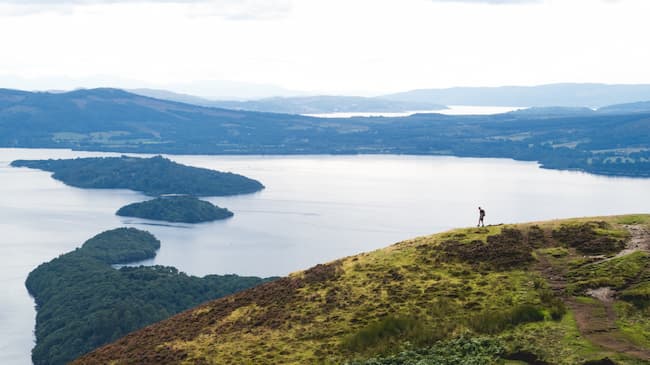
Those Incredible Crannogs
In Gaelic, Crannog means ‘son of tree’ or young tree’ and are seen in many of Scotland’s lochs (and those in Ireland too).
Crannogs were constructed by forcing lengths of timber into the soil of the loch bed, and then piling on rocks and other natural materials until an area big enough to support human dwellings was created.
These islands were accessible by boat, and were also often connected to the shore by long shale causeways.
Given how long ago this work was done, it’s an incredible feat of ingenuity, effort and engineering.
Historians and researchers are still not sure exactly why these crannogs were built in such large numbers, but their isolation and defensive qualities may have played a part, and it’s likely they had a number of different uses, over an extended period of time.
There are two descriptions of Loch Lomond’s monster.
One describes it as plesiosaur, an ancient type of marine reptile, and this fits with the description of both Loch Ness, and Loch Morar's monsters (and several other Scottish loch monsters as well).
If these creatures did somehow continue to exist in Scotland’s icy lochs for millions of years, their being of similar descendants would make sense.
The second description of Loch Lomond’s monster is of a creature who looks like a large crocodile or alligator.
This is unique among the monsters said to exist in many of Scotland’s lochs.
As crocodiles are also prehistoric creatures (Crocodilians existed in the time of the dinosaurs) who have somehow existed, relatively unchanged, for millions of years, a crocodile in a loch sounds at least within the realms of possibility to me!
But experts such as Dr Andrew Kitchener of the Royal Museum of Scotland insist that a crocodile would not be able to survive in the loch.
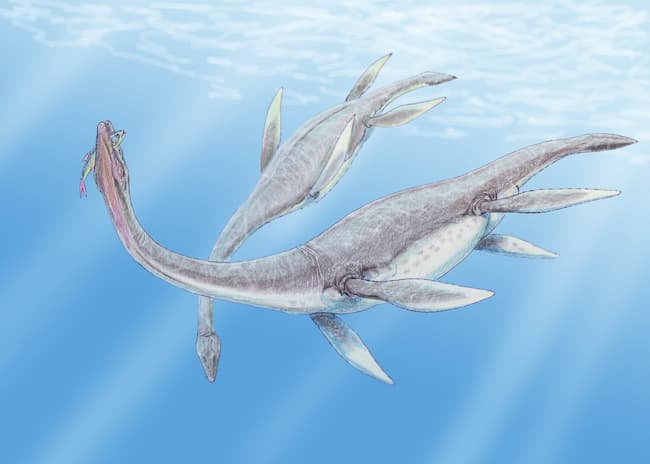 Artists recreation of Plesiosaurs
Artists recreation of Plesiosaurs
By Creator:Dmitry Bogdanov - dmitrchel@mail.ru, CC BY 3.0, https://commons.wikimedia.org/w/index.php?curid=3919828
Loch Lomond locals have reported sightings of a strange creature in the loch for centuries, but unlike Nessie and Morag, sightings of this loch's monster are rare, and largely undocumented.
In the only documented sightings of Loch Lomond’s monster I was able to find, it was the crocodilian variety that was seen.
1970’s: several local eyewitnesses, at different times, claimed to have seen a creature that was approximately 12 feet long and who looked like a crocodile, catching and killing ducks on Loch Lomond.
1976: Nick Taylor, a freelance journalist from Edinburgh, and some friends who were shooting a music video on the banks of Loch Lomond when they saw a strange creature swimming not far offshore. Taylor described it as gliding slowly through the water, and at times picking up speed to swim against the current. None of the group had ever seen anything like it and described it as a giant crocodile or alligator.
Loch Lochy - Lizzie
Loch Lochy (early Gaelic translation translates this to mean ‘lock of the black goddess’ or ‘loch of the dark goddess’) is a long, straight body of water with steep mountains on either side.
Loch Lochy is about ten miles long, and almost 3/4 mile wide on average, and is situated barely ten miles from Loch Ness. Between the two lies Loch Oich, and all three are connected by the Caledonian Canal.
For those who are energetic and like to walk/hike, the Great Glen Way is a walk from Fort William to Inverness, which includes stretches along the banks of Loch Ness, Loch Oich and Loch Lochy, and takes an average of 6 days to complete.
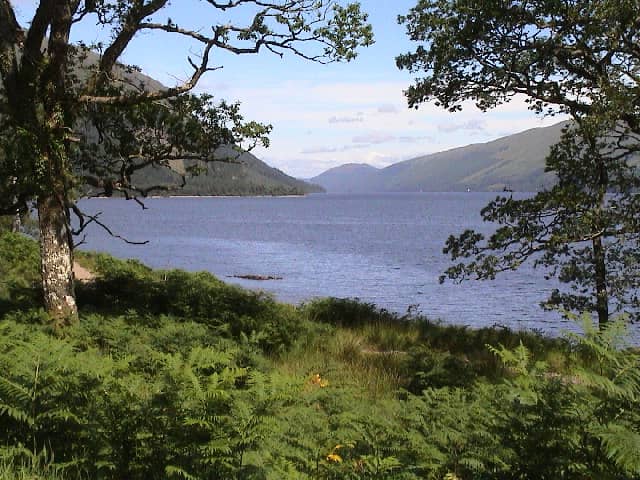 Loch Lochy, taken from the A82 which on the eastern shore
Loch Lochy, taken from the A82 which on the eastern shore
By Andrew McLean, CC BY-SA 2.0, https://commons.wikimedia.org/w/index.php?curid=663284
While Loch Lochy's Lizzie isn't as much of an exhibitionist as Nessie, she's also not as reclusive as some other loch creatures. There have been ten, well-documented sightings over an almost sixty-year period (1929-1997).
From the general descriptions, a Plesiosaur type creature is the most likely candidate, as with so many of the other Scottish lochs, but local folklore also recounts two other, more mythical creatures who were believed to live in Loch Lochy.
In 1925, the Queenslander newspaper in Australia, printed an article entitled ‘Peculiar Supersitions of Old Time Scotland’ which featured Loch Lochy and the two otherworldly creatures that were said to live in it.
One was a water horse, known as the Lord of the Lake (not a kelpie according to the description of his antics). This powerful horse was said to have overturned boats, lured mares from their pastures and was able to shake the whole universe with his motion.
The second creature was the River Bull, who supposedly emerged from the loch to have fun with the local cows, and apparently the Highland cattlemen of the time claimed they could tell which calves were fathered by the River Bull, and which were fathered by mortal bulls!
1929: two local
gamekeepers saw a large creature in the loch, they followed it but after about
a mile it submerged and disappeared.
1930: a local man saw a strange creature in the water
1960: ten people saw a huge creature in the loch near Glen Fintaig. They described it as approx. 30-40 feet long overall, dark colored with a lighter underside, possibly with fins.
1975: only one attempt at a photograph that I’ve been able to find (the wake left after the creature submerged is all that was captured). The sighting and photograph was taken on September 30th, 1975 by a local couple, Anthony and Margaret Sargent, who were driving on the road which runs along the eastern shore of Loch Lochy when a large, dark creature (what Margaret described as ‘an amazingly big creature’ that was approximately 6 feet across) surfaced right in front of their eyes. Hear the amazing story in their own words here.
1980’s: a visitor from England was fishing on the eastern side of the loch when he saw a large wake with a clear ‘V’ shape which made him think that there was something big moving just beneath the surface of the water.
1996: Staff and visitors at the Letterfinlay Lodge Hotel on the western bank of Loch Lomond saw a strange creature moving strangely through the loch.
1997: a local gamekeeper had his rod and tackle ripped out of his hands while fishing beside the loch. He described the feeling as trying to catch a rowing boat!
1997: an expedition was launched by the Official Loch Ness Monster Fan Club to search for Lizzie. On the first day they detected an approximately 20 feet long object at an approx. depth of 160 ft near the Letterfinlay Lodge Hotel. Within two minutes it was at 200 feet depth and then disappeared at a point where the water gets as deep as 300 ft.
2002: A woman and her mother saw a large disturbance on the lochs otherwise calm surface, with no obvious reason for it.
2021: A couple driving alongside the loch noticed a disturbance on the water, and a fin briefly appeared (which was similar to that of a plesiosaur). The creature never surfaced and disturbed water and a large wash (which they said was strong and loud when it hit the shore) was all that they managed to record. The only moving thing on the water at that time was a small yacht in the distance which wouldn’t have produced a wash like that and was far from the origin of the movement on the water. You can see the disturbance in a video they took here. Interestingly this is in almost exactly the same location, and looks incredibly similar to, what the Sargents saw in 1975.
Loch Arkaig
Located in the Scottish Highlands, Loch Arkaig lies about ten miles from the western coast, barely half a mile west of Loch Lochy and connected to it by the River Arkaig.
Loch Arkaig is a narrow loch, fairly isolated, with two small towns one at the eastern end of the loch, and the other at the western end. There is a single lane road that runs along part of the northern shore of the loch.
It's approximately twelve miles long and only 3/4 mile wide, with a maximum depth of about 300 feet. Surrounded by mountains and spectacular ancient forested land, it's a beautiful and peaceful spot.
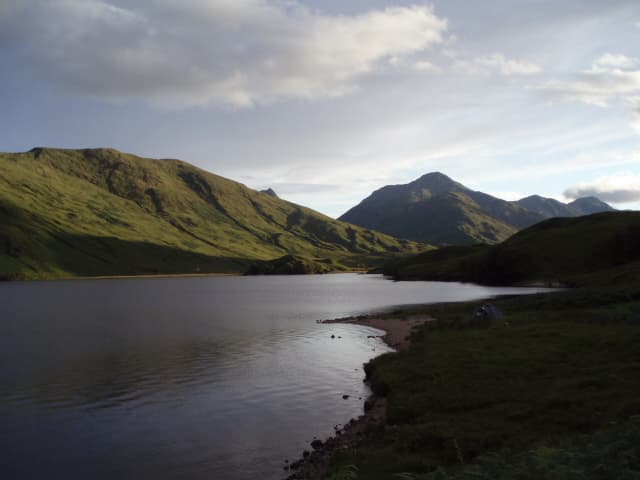 By Angela Mudge, CC BY-SA 2.0, https://commons.wikimedia.org/w/index.php?curid=1597643
By Angela Mudge, CC BY-SA 2.0, https://commons.wikimedia.org/w/index.php?curid=1597643Loch Arkaig’s monster is said to be of the water horse variety, but early eyewitness reports describe it as having a long neck, wide body and four flippers, which sounds (unsurprisingly to me) like the plesiosaurus monsters in both Loch Ness and Loch Lochy.
1857: On October 3rd of this year is the first documentation of sightings (plural) of the Loch Arkaig monster by Lord Malmesbury’s stalker, John Stuart, and his children.
Although by his own admission a skeptic, Lord Malmesbury was convinced that Stuart and his children had seen the loch creature and recorded the details in his diary.
The description given by the Stuart family was that of a large creature that wasn’t shaped like a fish or a seal, and with a head that looked like a horse, and powerful hindquarters.
Each time it was seen floating quietly on the surface of the loch.
In one encounter it was about 30 yards from the shoreline and when the children tried to get closer to the water for a better look, the monster moved it’s head, which (understandably) terrified them and they ran home.
You can read more about this sighting in the book ‘The Leviathans’ published in 1966. You can also read The Leviathans online here at Google Books or see an excerpt relating to the incident from the Diary of Lord Malmesbury in the Clan Cameron Archives at http://www.lochiel.net/archives/arch179.html
The writer, Tim Dinsdale, describes a recounting by two WWII veterans who had been based in the Loch Arkaig area and, while out on the loch, had almost been dumped out of their inflatable boat by a huge upheaval in the water.
They didn’t actually see the monster, or any giant fish or eels, but something caused the swell and it must have been huge.
Loch Awe
Loch Awe in Argyll and Bute, on the west coast of Scotland, is Britain’s longest lake, measuring a total of about 25 miles, and reaching over 300 ft. at it’s deepest point.
Like with many other large Scottish lochs, there are several islands or islets in Loch Awe (including Innis Chonnain and Inishail) and four castles (including the reportedly haunted Kilchurn Castle, Innes Chonnel, Fraoch Eileen and Fincharn).
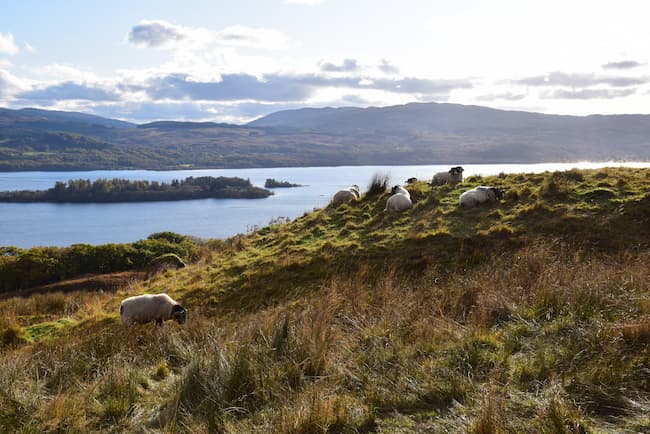
The area has featured prominently in Scottish history, with nearby Dun Add Fort the location where kings of the ancient kingdom of Dal Riata were crowned, Innis Chonnel was the original seat of Clan Campbell, and a battle being fought (and won by Robert the Bruce) at the west end of the loch in 1308.
There are also many legends, stories and documented personal experiences of paranormal activity on and around the loch.
The history and sightings of a monster in Loch Awe also go far, far back in time but have been considerably less well recorded.
Legend has it that fisherman as long ago as the 17th century claimed that giant eels, as big as a horse, lived in the loch, but no names, dates or details are available (or at least that I could find).
There appears to be one lone, documented sighting of a monster in Loch Awe which is also undated and given by a man named Timothy Pont.
His description of the creatures (interestingly in the plural) were also of incredibly long, and gigantically big, eels. He described them as having ‘the girth of a horse’ but there’s no reference to horse-like features.
Pont was also documented as saying these creatures frightened fishermen from the loch, and were seen on the loch shore during the winter, which infers that they were seen regularly.
You can see an up close and personal account of being on Loch Awe at Off The Beaten Track
Loch Linnhe
Loch Linnhe is a sea loch that sits on the Great Glen Fault, on the western coast of Scotland. The word Linnhe comes from the Gaelic word for ‘pool’.
At about 30 miles long and less than a mile and a half wide at some points, it’s a long and slender loch, it’s also fairly deep in places and reaches a maximum depth of 492 ft.
It’s connected to Loch Lochy by the River Lochy at the northern end, and opens up into the Sound of Mull and Firth of Lorneon the southern end. It’s geography is similar to the fjords of Norway.

Conger eels, porpoises, dolphins and sometimes Minke whales have been seen in the waters at the southern end of the loch where it meets the ocean, however none of these resemble the creature that eyewitnesses describe.
The first documented sighting of Loch Linnhes monster was in the mid 1940’s when an eyewitness described seeing a large, brown creature with a long neck and short horns in the loch.
There have been a handful of documented sightings since then including:
1954: a man named Eric Robinson got a brief glimpse of a three-humped creature moving across the loch. He estimated it to be moving at around 30mph and it was leaving a substantial wake behind it.
1964: a woman named Mrs Preston said she saw the neck and head of a strange creature in the loch. I couldn’t find any further description.
1967: several of the Muir family saw a creature with a snake-like head and two or three humps in the loch. They watched it for around ten minutes.
Other Scottish Lochs with Monster Sightings
Scotland has thousands and thousands of lochs (around 30,000), and many of them are the site of strange creature or loch monster sightings.
Obviously it's impossible to cover them all here, but the lochs listed above are the ones with the most well documented and frequent sightings.
There are a few more worth mentioning, although there is much less information on them. They include:
Loch Treig
Loch Treig is a steep-sided, freshwater, Highland loch in Lochaber (the name means Loch of Death) it is sometimes called 'The Lonely Loch' due to it's isolation. It's about 5 miles long, has a maximum depth of approx 436 feet and has been a reservoir since the late 1920's.
According to folk tales, this loch was once home to numerous water horses. I couldn’t find any documented reports of monster sightings, but as recently as 1933 several divers working on a hydroelectric project quit or asked to be moved to other projects because they claimed there were monsters in the loch.
Totally unrelated to monster sightings, but fascinating nonetheless, is the story of Loch Treig's very own 'hermit', Ken Smith. Now in his 70's, Ken has lived alone in his self-built log cabin by the loch for almost 40 years. You can read more HERE.
Loch Maree
Loch Maree (aka Loch na Beiste or Loch of the Beast) is an almost fourteen mile long loch in the northwestern Highlands, with a maximum depth of 367 feet.
Features of this loch are the three 'basins' from which it's formed, and the number of islands doted throughout, many of them forested and a prime source for native Caledonian pinewood. Isle Maree is the site of an ancient Oak wishing tree, and the island is believed to have been used for pagan worship before Christian times.
Loch Maree is said to be home to the Muc-Sheilch (loosely translates to ‘turtle-pig’).
However, the few sightings of this loch turtle-pig describe a creature with several humps which is more in line with the Nessie type plesiosaur type monster.
Loch Tay
Loch Tay is a large, but narrow, freshwater loch in the central Scottish Highlands, it's approx. 14.5 miles long, is only 1 to 1.5 miles wide and has a maximum depth of around 500 ft.
The Ben Lawers mountain range stretches along the northern shore, with a large part of that area being a National Nature Reserve. Loch Tay also has eighteen man-made crannogs (find out more about these small islands here) from the Iron Ages, but many of them are now underwater.
The incredible, and well documented, sightings of Loch Tay's loch monster didn’t actually take place IN the loch, but on the banks of the River Tay/Firth of Tay.
In September 1965, a strange and unidentified creature was seen by two totally separate and unconnected drivers on a quiet stretch of the A85 near Perth, over a two hour period.
The creature was first seen around 11:30pm by Maureen Ford and friends. It was by the roadside and she describes it as being long and gray, with no visible legs, but it did have long pointed ears.
Approximately two hours later, Robert Swankie was driving on the same stretch of road but in the opposite direction when he saw an incredible sight (on the opposite side of the road from where it was seen earlier that night).
He slowed down and opened his window to get a better view and this is how he describes it ‘The head was more than two feet long. It seemed to have pointed ears. The body, which was about 20 feet long, was humped like a giant caterpillar. It was moving very slowly and made a noise 'like someone dragging a heavy weight through the grass.’
Loch Garten
Loch Garten is a large freshwater loch, located in the Cairngorms National Park, and surrounded by the ancient pine trees of Abernathy Forest. It's home to the Loch Garten Nature Reserve and Osprey Center, you can see the Osprey Cam here on youtube.
According to local folklore, Loch Garten used to be home to an enormous Tarb Uisge (aka a water bull) with a horned head, black mane and deafening bellow.
 Loch Assynt
Loch AssyntLoch Assynt
Loch Assynt sits about five miles inland from the spectacular west coast of the Scottish Highlands, and is just over 6 miles long with a maximum depth of just under 300 feet. This highland loch is surrounded by mountains and boasts the ruins of Ardvreck Castle (held by the MacLeods and also the Mackenzies during it's history) on it's northern shore.
In 1837 two fishermen claimed to see a strange creature twice, once in the water and once on small islet in the loch.
They described it as being about the same size as a young bullock (approx.. 3 feet tall), with a broader back, bull-dog type head, gray and hairy.
Lochan Feith an Leothaid
Lochan Feith an Leothaid is a small hill loch in the Scottish Highlands, and is only a few thousand feet south of Loch Assynt.
In 1930, almost a century after the sighting of the strange creature near Loch Assynt, Kenneth MacKenzie described seeing a strange creature with a deer-like head surface close to his boat on Lochan Feith an Leothaid, before diving back under water.
Citations & References used for info. on this page
- Scholarworks.uni.edu
- Cryptidz.fandom.com Loch Oich Monster
- Wikipedia Each-usige
- Cryptopia.us
- books.google.com Beasts of Britain
- Edinburgh University Carmichael-Watson Project
- The Daily Record Newspaper UK
- The Daily Mail Newspaper UK
- bbc.com
- The Queenslander Newspaper
- http://karlshuker.blogspot.com/2015/07/lesser-nessies-reviewing-other-monsters.html
- Home
- Loch Monsters